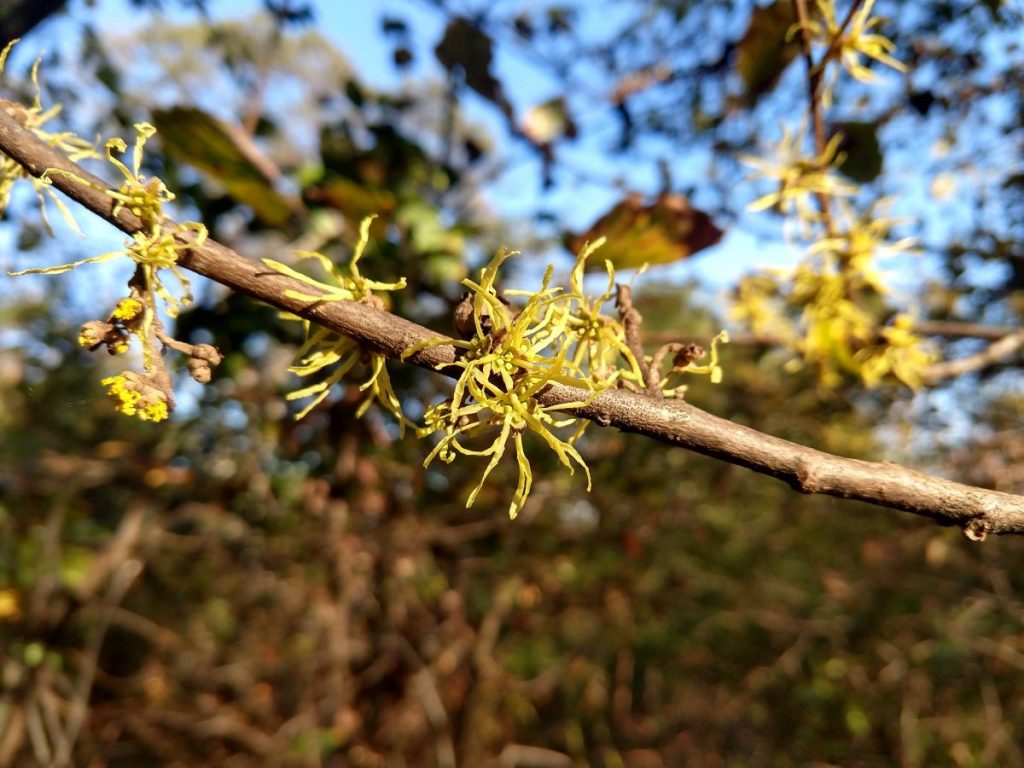by Kate Shunney
Our woods don’t offer up a lot of color in wintertime. That’s why the feathery yellow bloom of the witch hazel tree stands out to anyone scanning the hills and mountains from the late fall to the midwinter months of the year.
Because it only grows as a short tree (or a tall shrub, depending on who you ask), that witch hazel bloom is often right at eye level for those of us poking around outside this time of year.
Like many plants and trees, witch hazel has varied looks at different stages of growth through the year. In spring, its bright green leaves stand out, thick and sturdy with heavy veins and toothed edges. At that time of the year, buds form in hard balls – grayish-brown gnarly things that aren’t very appealing. They contain small black seeds, which drop out in fall.
Right now, a pale yellow bloom is still clinging to witch hazel branches all around us, hanging tough through the rougher weather.

Witch hazel in bloom in downtown Berkeley Springs in December.
My first close encounter with the witch hazel was on top of Cacapon Mountain on a hike along the Ziler Trail. It was late in the year, so the dots of yellow in the trees drew my curiosity. I took some pictures of the thin, fringy bloom, hoping to be able to identify it later when I got home. Sure enoug
h, a book about Mid-Atlantic native plants had a photo of the witch hazel. No question — it was the same plant.
Once I knew it, I looked for witch hazel all over the woods. For months after, I only saw it growing on the upper portions of Cacapon Mountain, and wrongly concluded the slender tree only grew in higher elevations. Another season of noticing the tree set me right – it grows all over in Morgan County (and elsewhere, of course), including in the old cemetery in downtown Berkeley Springs near Roy’s Service Center.

Witch hazel’s bloom in October.
I’ve since seen witch hazel growing everywhere I hike, and in different formations. Sometimes the tree is tall – reaching 12 or 15 feet. Sometimes trunks grow down along the side of a mountain in clumps of five or six, more squatty than tall. They can be short and slender, or stretch out wider in forested areas, reaching for more light.
That light yellow fringed bloom doesn’t smell sweet, like some flowering trees. It has a sharp odor when crushed between your fingers.
That smell is a small indication of what herbalists and medicine folks have found most useful in the witch hazel – its astringent qualities.
The tree has been known since Indian times to have the ability to stop bleeding, heal burns and skin inflammation, calm bug bites and poison ivy rashes, soothe hemorrhoids, sore muscles and bruises.
Plant experts have identified many of the compounds in the plant that give it healing properties, from flavonoids, tannins and small amounts of oil.
Some herbalists make their own preparations from parts of the plant – choosing the leaves, twigs and inner bark for their different healing qualities. Chipped branches and bark are steam-distilled by commercial manufacturers like the Dickinson’s company of Connecticut.
Witch hazel liquid extracts and wipes are widely available in grocery stores and pharmacies. Even though some consider it an old-fashioned remedy for various ailments, witch hazel has been a staple in medicine cabinets for more than a century.
American witch hazel has another claim to fame beyond skin care. It’s known to be the branch of choice for dowsers – people with a reputation for being able to find water underground.
Dowsers have been called upon to help locate good spots to drill water wells for a home or a farm.
According to the U.S. Forest Service, early European settlers saw American Indians using witch hazel branches to find underground sources of water.
“This activity is probably where the common name witchhazel came from. ‘Wicke’ is the Middle English for ‘lively’ and ‘wych’ is from the Anglo-Saxon word for ‘bend.’ American witchhazel was probably called a Wicke Hazel by early white settlers because the dowsing end of the forked branch would bend when underground water when detected by the dowser,” the Forest Service booklet on witch hazel says. “This practice had a widespread use by American settlers and then exported back to Europe. Dowsing became an established feature of well-digging into the 20th century.”
In the New England states, where witch hazel is native, the plant is also known as winterbloom, snapping hazel and spotted alder.
Botanical folks know witch hazel as Hamamelis virginiana – and the second part of its name indicates the region where the plant is native.
One last feature of the witch hazel that makes it stand out is the action of its seed pods. While I have yet to see it myself, tree experts say that in the fall the grayish-brown seed capsule, when ready, will burst open violently, spreading its black seeds out as far as 25 feet from the tree branch!

Witch hazel seed pod.
Turkey, woodland birds and small game like squirrels are known to eat the seeds, guaranteeing the witch hazel will continue to be planted around the local woods without any help from humans.









